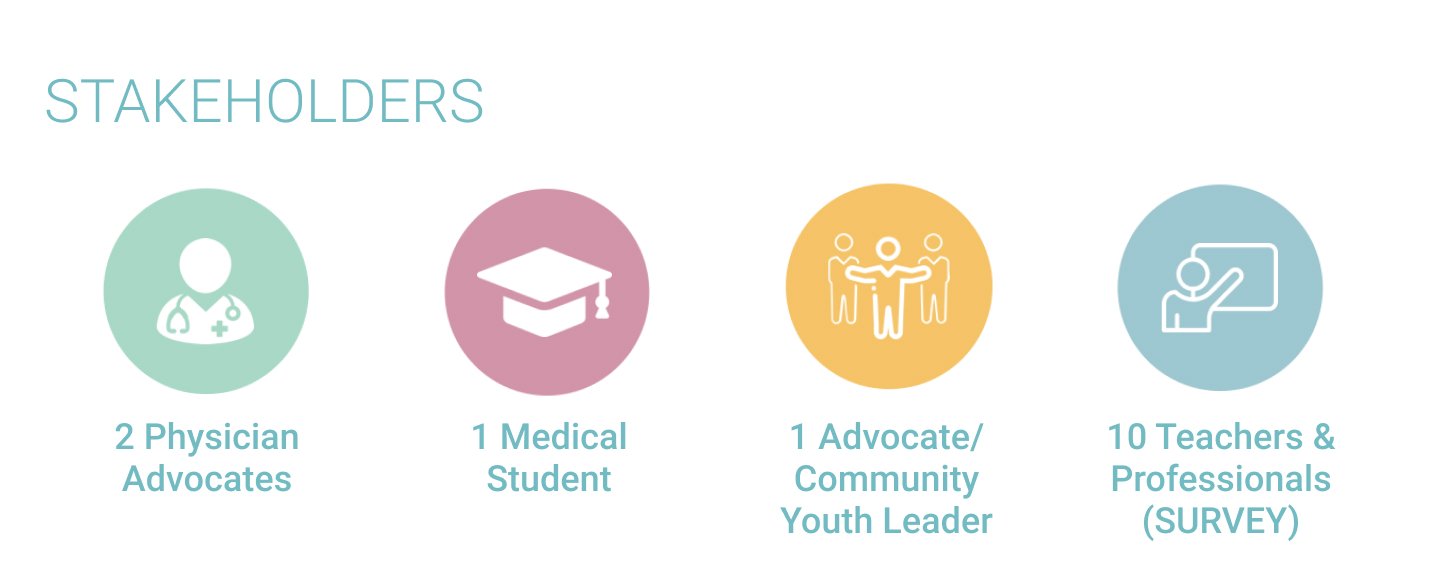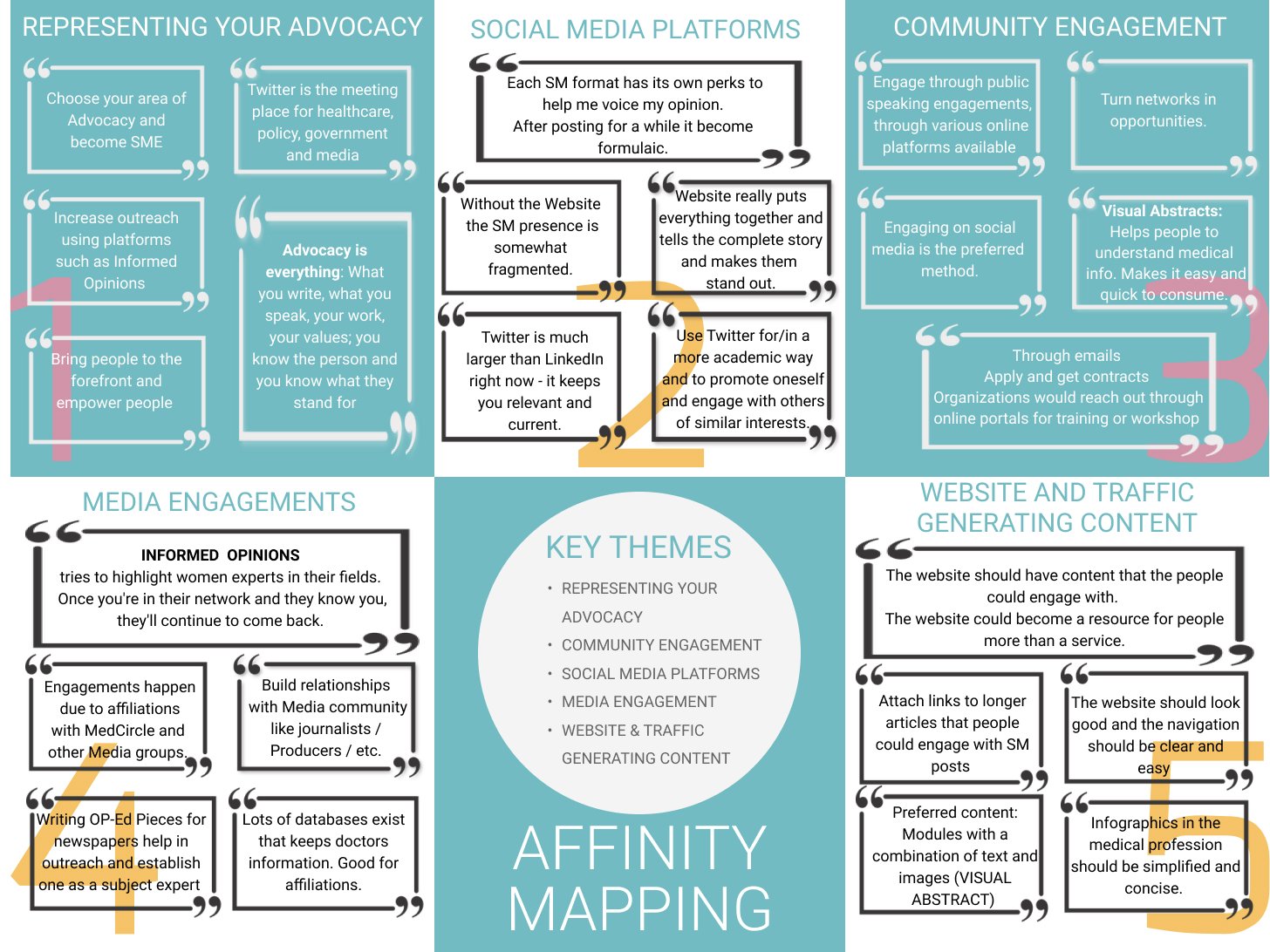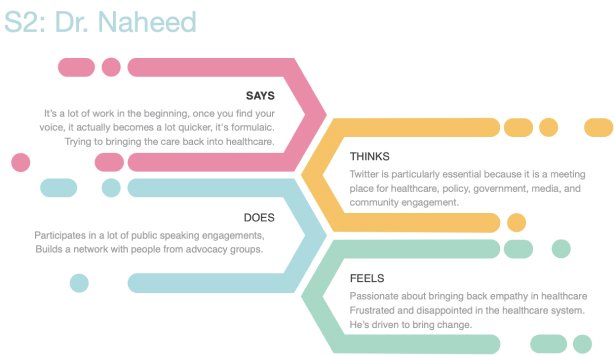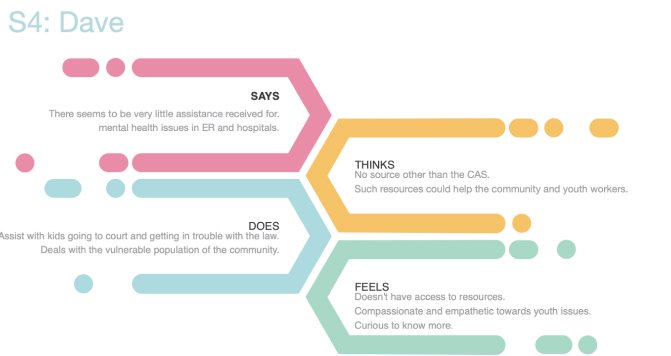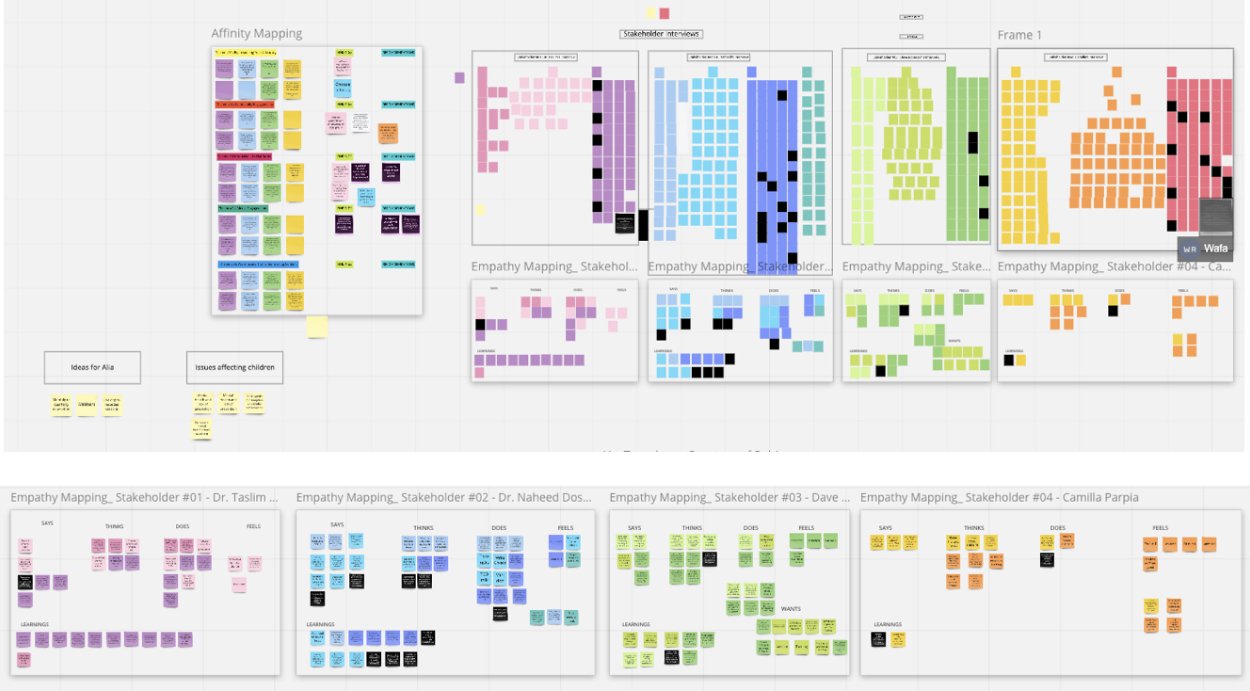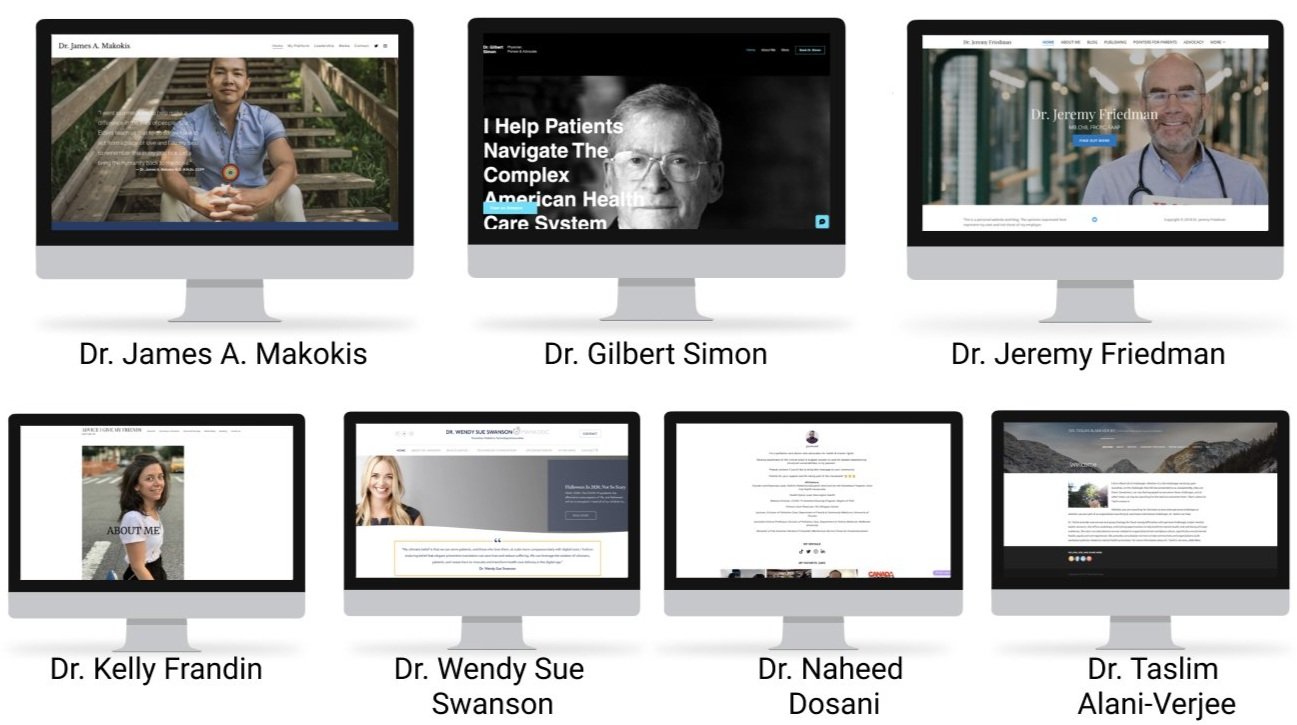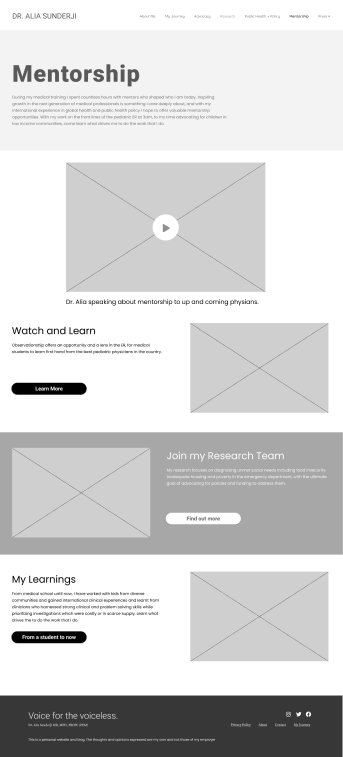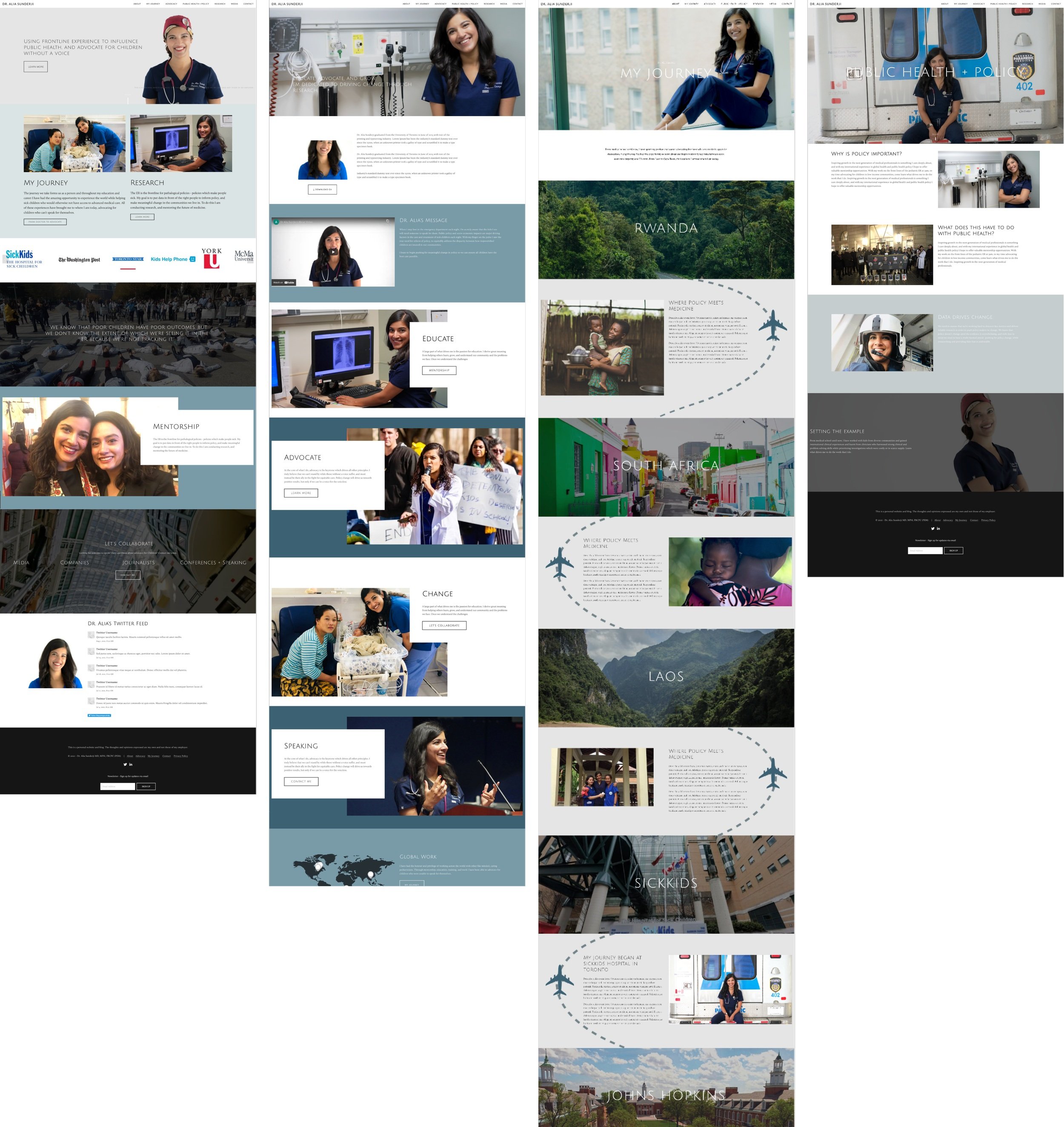E.R. Physician’s Website
CASE STUDY
A website designed for Dr. Alia to advance her advocacy efforts and establish her brand, featuring strategic content aimed at driving increased traffic and addressing existing gaps in healthcare and public policy advocacy.
Industry
Medicine/Healthcare
Duration
8 Weeks. Jul-Aug
Role
UX Researcher
Tools
Miro
Figma
OUR CLIENT
Dr. Alia Sunderji
MD, MPH, FRCPC (PEM)
Dr. Sunderji is a pediatric emergency room physician at SickKids Toronto and a public health advocate seeking to launch a public-facing website that profiles and integrates her international background, practitioner expertise, and policy vision for improved child health, locally and globally.
Intent and Scope
Improve readability/usability and findability of Dr. Sunderji's academic writings, interviews, and other featured content.
Create a modern aesthetic and storytelling theme that resonates with her target audiences.
Provide relevant information to target audiences.
Make the site easy and quick for Dr. Sunderji to update.
Create an aesthetic that reflects Dr Sunderji’s modern yet rooted philosophy.
Clearly defined branding.
Our Team
-
Wafa Rizvi
UX RESEARCHER

-
Adam Beasley
UX DESIGNER

-
Shaun Duffus
UX DESIGNER

-
Helen Galligan
PROJECT MANAGER

design process
Research
Ideate
Design
Test
Takeaway
1. Research
Research Methodology
The initial phase had been pivotal, with a strong emphasis on user research—an essential aspect of our project's success.
We dedicated significant effort to identifying key stakeholders, and thoroughly researching our client's background and aspirations through interviews and analysis.
Engaging with users provided invaluable insights into healthcare and advocacy.
1.1 Stakeholder Analysis
Through a series of interviews and survey feedback, the team was able to gain important insights into the current status of communication among the medical community, engagements with media and other advocacy organizations, the importance of Social Media platforms while creating a brand, the strategic content that helps generate more traffic and the gaps that exist in the realm of advocacy for healthcare and public policy.
INTERVIEW PARTICIPANTS INCLUDE
Interview Excerpts
Stakeholder #1:
Dr. Taslim Avani-Verjee
“You have to live and breathe your advocacy.”
“Advocacy is everything: What you write, what you speak, your work, your values; you know the person and you know what they stand for.
Be ready to take a stance, you could say the wrong thing, or pick the wrong side, and there's vulnerability to that.
If you're positioning yourself as an advocate: Be ready to advocate, even against the bodies that pay for your livelihood sometimes, because our systems are broken”
Stakeholder #2:
Dr. Naheed Dosani
“Out of sight, out of mind.”
"If you want to make a website for a physician if they're not hustling, you can take them to water but you can't force them to drink it. It can be an amazing website but they have to prioritize this."
"You need to be a subject matter expert, which helped me with my growth"
“People follow the people that they follow and trust.”
“You have to be timely, and aggressive when the news happens, and you have to build relationships.”
Stakeholder #3:
Camilla Parpia
“Clarity about availability feels more inviting to contact the physician”
“The students want to learn about the physician's journey and know how they grew...from being in their shoes to becoming the incredible people they are today”
“Gravitate towards physicians who have done an interview about their process or their life, different aspects of why do they choose to mentoring research (particularly important for medical students) to know how this person could help them grow”
Stakeholder #4:
Dave Robinson
“People might not even be aware of the fact that the medical issues they are facing are due to a bad policy”
“Experienced that there's a shortcut to diagnoses that includes accusing people of things that could be hurtful, particularly for young people, especially in Mental health-related cases”
“Need a one-stop shop to find resources, or perhaps point the users in the right direction. Learning about people beyond their professional life, personal aspect of their work, and what they do in their free time is helpful to know what matters to them”
1.3 Affinity Mapping
Affinity mapping is a useful method for organizing large amounts of qualitative data gathered from interviews, organizing the data points into themes based on their relationships.
The following are key themes revealed during the stakeholder interview process:
• Representing your advocacy
• Community Engagement
• Social Media
• Media Engagement
• Website and Traffic Generating Content
1.4 Empathy Mapping
The Chaotic BTS Miro Board
1.5 Competitive Analysis
In conducting a competitive analysis, seven physician websites were carefully chosen. These websites underwent thorough evaluation, focusing on their respective strengths, weaknesses, and market positioning.
The questions analyzed for the selected websites:
How do they explicitly position themselves? What do they say they offer?
Who do they appear to be targeting? How does this overlap or differ from your target audience or users?
What are the key differentiators? The factors that make them uniquely valuable to their target market, if any?
To what extent do they embody each of your positive/negative Attributes?
What do you notice that they’re doing particularly well or Badly?
1.6 Lean Canvas and Value Proposition
We consolidated our lean canvas and value proposition canvas findings to refine our final versions collaboratively.
Utilizing the business model canvas, we gained insights into Dr. Alia's services and clientele, identifying opportunities to address market gaps effectively.
We crafted the website's information architecture and presented several low-fidelity wireframes for different site pages to the client.
1.7 Summary of Research Findings
Businesses seek pediatricians to weigh in on the viability of their products.
Advocacy organizations may have difficulty finding pediatricians to engage with for their projects.
Medical students interested in advocacy often search for mentors.
Nobody in Canada does social determinant screening in the ER
There’s no evidence-based research in healthcare to influence or support health policies.
Healthcare Advocacy groups lack credible voices to support their causes.
Media needs subject matter experts to highlight issues related to children and public health barriers.
Students can’t find accessible mentorship and inspirational journeys to learn from.
1.8 Key Findings and Insights
Advocacy
Must choose a focus to be considered as a Subject Matter expert.
Twitter link to the website.
Align with various platforms, advocacy groups, and other media organizations.
Research
Research should back your advocacy.
Content should be engaging and could be used more as a resource by the users to come back to the website.
Mentorship
The Mentorship page should be transparent.
Students want to be inspired by your journey from being a student to becoming a doctor
2. Ideate
2.1 Sitemap / Information Architecture
2.2 Low-fidelity Wireframing
The wireframe layouts for the website were designed from our conversations with Dr. Alia as well as our research findings.
These wireframes marked the beginning of the iterative design process.
As a team, we collaborated to streamline our efforts, creating low-fidelity wireframes for the different pages of the website.
These pages included the Homepage, Advocacy page, Research page, Journey page, About page, Mentorship page, etc.
We shared the wireframes with the client and made adjustments to the architecture based on her input.
2.3 Color Scheme Exploration
2.4 Typeface | Logo/Font Exploration
2.5 Moodboard
3. Design
3.1 High-fidelity Wireframing
We presented the client with three website concepts and six logo options, informed by feedback gathered from the low-fidelity wireframes and mood board color schemes.
Subsequently, the team developed three high-fidelity concepts for various website pages, offering the client options to select from.
Receiving positive feedback from the client, who appreciated our efforts, was highly rewarding and validating.
3.2 Prototype - Squarespace Website
4. Test
4.1 Usability Testing
Our usability testing focused on two key areas, which have the potential to have a significant impact on how users interact with the website:
1. Understanding the purpose of the website
2. Usability testing focused on accessibility and functionality
Prototype Users: 11
Tasks: 2
Questions: 7
After the client selected a design concept, incorporating elements and ideas from other concepts, we began building the prototype on Squarespace.
Completed the high-fidelity prototype on Squarespace.
We conducted user testing sessions via Zoom, where participants were tasked with providing feedback and completing assigned actions.
During testing, challenges arose concerning legibility, content clarity, and typography hierarchy.
4.2 Usability / Accessibility Feedbacks
“Yes, I thought it was simple to navigate and quite effective..”
— User #1
“The ‘About’ page is great, and the colors look awesome. Great photography.”
— User #3
“She looks compelling and interesting, and I like her mission.”
— User #5
“The font hierarchy could use more sizes and some color to call out to things.”
— User #4
“Some of the fonts on the graphics are hard to read. But overall the website is clear and concise.”
— User #2
“
FINAL Live Website
5. Takeaway
Research sets the stage for success.
Communication is vital to a project
Speaking about scope regularly keeps the project on track.
Timeboxing helps you set a small deadline for yourself so you can reach an endpoint.
Project management is really important, communicating back and forth with your client.
In a time crunch, play to your strengths and divide and conquer.
Maintaining a single line of communication with clients and co-workers keeps things neat.
Spreading out over too many communication methods can cause confusion and delay.



